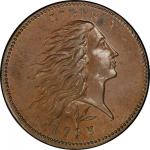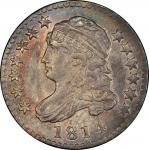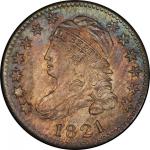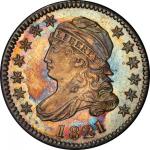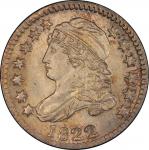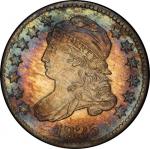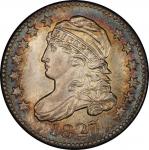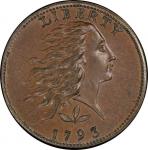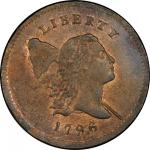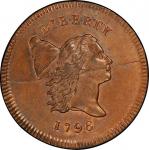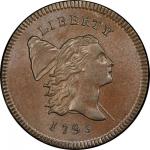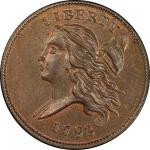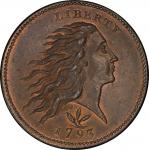“The discovery of new dies of the cents of 1793, as well as of new combinations of dies previously known, has led me to undertake to describe them ...”— Sylvester S. Crosby, The United States Coinage of 1793 Cents and Half Cents, 1897 Abundant mint color surrounds all design elements, more prominent on the obverse than reverse, though both sides are bathed in similarly robust and frosty cartwheel luster. Those areas in the fields that have mellowed past red are now elegant golden tan, retaining hints of violet and pale blue in some protected areas. The strike is exacting, and both sides are framed by a full ration of fine beads at the border. The reverse is aligned trivially to the southeast, leaving little space outside the beads at 5:00 but a good deal of space outside the border at 10:00. Some planchet texture remains inside the reverse border between 6:00 and 8:00, but it has been struck out nearly everywhere else. The fields are pristine, with no significant marks, scratches, or visible hairlines, just two faint and shallow marks parallel to Liberty’s lips in the right obverse field and a scattering of minor contact points on Liberty’s cheek, not to be confused with texture there that can be attributed to the die state. A short lintmark is seen low on Liberty’s cheek. The aesthetic appeal is magnificent, surpassing nearly every survivor of this much acclaimed design type. The dies have clashed and cracked, placing this as Breen’s state VII. The clash is subtle on the obverse, with an impression of the wreath leaves beneath Liberty’s chin and atop the trefoil spray above the date. The fields are somewhat flowlined, and light surface cracks are seen on Liberty’s portrait, stretching north from the corner of her eye and east across the side of her neck. Another faint crack from Liberty’s ear passes over her cheek, which has earned some pebbly texture in this die state. Significant die cracks are seen at the base of the reverse, and some evidence of die clashing manifests as an impression of the trefoil spray in the space at the wreath opening. Lapping or grinding has created some roughened texture atop the wreath and below the wreath’s lower right side, but it did manage to efface die clash evidence in those areas. The largest crack stretches from the rim above C in AMERICA, through CA, the right wreath end and the ribbon end, to the field above the numerator. Another runs along the line of the fraction bar and crosses the tips of the left ribbon end before stopping at the upper left serif of U of UNITED; a different crack begins at the base of that letter and connects UNIT. A short but heavy crack connects R of AMERICA to the rim above and the berry spray below, with a substantial break in the die below the upper left serif of that letter. Even though the Sheldon-9 is lodged in the middle of Crosby and Sheldon’s descriptive sequence, modern research suggests this is one of two varieties with a claim to have been the first Wreath cent struck. The obverses and reverses of the 1793 cents were impeccably described by Crosby in 1897, well enough that Sheldon commented in Penny Whimsy that “Crosby’s book was so accurate and complete that in the half century since its publication no further varieties of 1793 have been found.” Ironically, it took until the age of encapsulation for researchers to pay proper attention to edges. In a paper that arose from the study of the Strawberry Leaf cents, Jim Neiswinter published observations made in concert with Dan Holmes, Bob Grellman, and then-current and former ANS curators Robert Hoge and John Kleeberg regarding the edge dies of 1793 cents. His article appeared in the March 2005 issue of Penny-Wise, following comparison of the two Strawberry Leaf cents owned by Dan Holmes to the Parmelee specimen, when on consignment to American Numismatic Rarities in 2004, and the specimen owned by the ANS. Neiswinter et al discovered that all Wreath cents except for Sheldon-8 and Sheldon-9 shared the same edge die. The Strawberry Leaf cents likewise shared this device. The Sheldon-8 and Sheldon-9 edge device was produced from the same edge die that milled the edges of all Chain cents that were studied, including Sheldon-1 through Sheldon-4 and 1793 NC-1. This edge evidence confirms that the planchets used to strike Sheldon-8 and Sheldon-9 were milled before the planchets used for the other Wreath cents, prior to the edge dies being changed in the Castaing machine (also known as an edge mill). While the first planchets prepared do not necessarily need to have been the first planchets struck, the evidence Bill Eckberg published in Penny-Wise in September 2010 is persuasive. The coiner’s account book consulted by Eckberg, discovered in the National Archives by Craig Sholley, shows that while Wreath cent planchets were being milled from April 3 to April 6, Wreath cent coining began on April 4, confirming that the final Wreath cent planchets to be milled were among the last to be struck. Eckberg posits that the milling process had begun a few days before April 3, but the surviving documentation begins on that date; the earlier account book has not been found. Eckberg’s 2010 study also delved into emission sequences and die states. Sheldon-8 and Sheldon-9 share an obverse die, but the die state of that obverse is always later on Sheldon-8 than on Sheldon-9. This obverse, Crosby’s Obverse 9, was also used on 1793 NC-4, but all four survivors of that variety are too low grade to determine their die state. Gathering the die state evidence and the edge die evidence, the data strongly suggests that either NC-4 or Sheldon-9 was the first Wreath cent struck. This piece initially appeared in 1973, first handled by California coin shop proprietor Herman Engelhardt, who handled several important large cents during the era in which he flourished. While coins of this era found in Europe sometimes have no previous provenance within numismatic circles, those found in California have rarely been there since the 1790s, suggesting that this coin has some prior, if unknown, collector provenance. Mal Varner has recounted that this coin was included in a type set assembled in southern California by collector I. Newton Sanders, probably in the 1940s or 1950s, and suggests that its source was likely a substantial holding of high grade coins assembled in the 19th century and acquired by dealer Herman Engelhardt in the 1920s or 1930s. Reacquired by Engelhardt from the son of the man he sold it to, the coin was sold to Varner in 1973 before its placement in the Allen Harriman Collection. Del Bland’s census details a few unseen high grade examples whose provenance chains dead-end before 1973, but none of those trails seem to correspond with this coin. The Henry Miller-Dr. French coin was singled out by Dr. Sheldon in Penny Whimsy as one of the finest of this variety, but comparison with the 1917 Miller sale plate reveals no apparent match. The George H. Hall coin, sold in our May 1945 auction as lot 174 and earlier from Elder’s sale of June 1937, is almost certainly the Sheldon-9 that later went to Dr. Sheldon and is currently graded MS-69 BN (PCGS). The only remaining superb Sheldon-9 with an orphan provenance that ends before 1973 is the coin from the Reakirt Collection, acquired from W. Elliot Woodward in 1866 and dispersed by descendants in relatively obscurity in 1963. No photographs are known of the Reakirt coin, and thus proof may never come to link it with any prior or later provenance. The most modern description of the Reakirt coin comes from Woodward’s March 1865 auction, in which Woodward described that cent as “1793 Flowing Hair, perfectly uncirculated, with splendid surface resembling a proof; a finer one of this date is not known.” The date of the Reakirt Collection’s dispersal makes a Reakirt provenance for this coin unlikely. This coin is listed as tied for finest known Sheldon-9 in the Bland census, a position it shares with the Crosby-Brand-Koshkarian coin that is currently graded MS-66+ BN (PCGS). The Noyes census places the Koshkarian coin first and this one second, though he assigns them both the same grade. The only example graded finer by PCGS among circulation strike Wreath cents is also a Sheldon-9, but that coin is counted as tied for fifth finest known by Bland and third finest known, behind this specimen, on the Noyes census. Only three Wreath cents have ever earned a designation other than BN by PCGS. This is the finer of two RB coins, surpassing the MS-66 RB Sheldon-6, from Bement (1916), French (1929), and the July 2004 American Numismatic Rarities sale. The single 1793 Wreath certified by PCGS as a Specimen is the Atwater Sheldon-5, graded as Specimen-68 RD in 1992. The Sarah Sophia Banks Sheldon-9 has been at the British Museum since 1818 and, while Mint State, is unlikely to ever be certified. PCGS# 35460.

